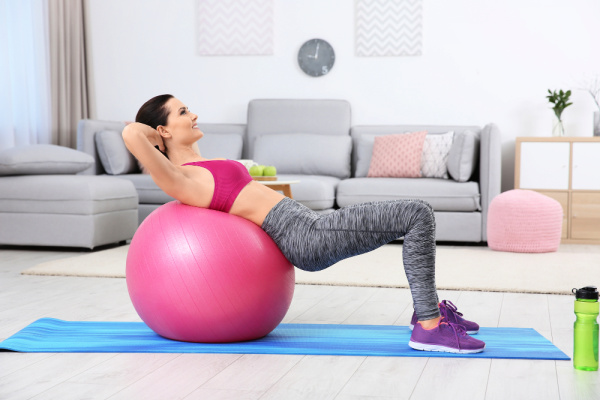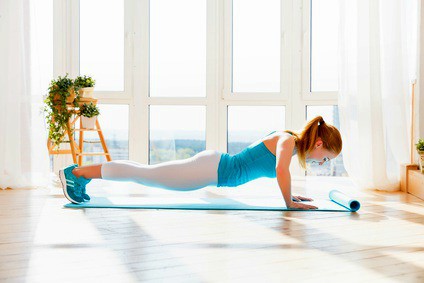5 Simple Ways to Make Time for Exercise
As a busy woman, you probably struggle every day to accomplish all the things you need to do. In fact, I’m fairly certain that you end each day with items still on your to-do list, because you just didn’t have time to get to them. And that means that figuring out a way to make time for exercise, which is so important but so easy to put off, is probably something you struggle to do.
Even if you really want exercise regularly, you run into a big problem – it’s just flat-out hard for busy women to make time for exercise. (Includes Amazon affiliate links.)

But regular exercise is important – really important. It can make a tremendous difference in your health, peace of mind, and quality of life. It can help you feel less stressed, sleep better, feel more energetic, get stronger, and lose weight.
In fact, few things give you as much return on your “investment” as almost any kind of exercise – walking, jogging, hiking, biking, dancing, and just generally getting up and moving.
5 Ways to Make Time for Exercise
So if you’re struggling to juggle everything you have to do, here are 5 ways to make time for exercise, even if you don’t have time:
1. Decide that you are worth it.
Many women devote so much time to doing things for others, they run out of time to do things for themselves. Yes, your children’s sports and social activities and your volunteer work are important, but they’re not as important as your health.
And they’re not as important as your mental health and peace of mind. So decide that your body and mind are worth at least 150 minutes of physical activity each week (equivalent to 30 minutes a day, 5 days a week), the minimum amount recommended by the Physical Activity Guidelines for Americans.(1) And if you struggle to make that decision, use the Healthy Life Tools to make it easier – especially Tool #2 – Decide That You are Worth It and Tool #3 – Create a Mindset that Works for You, Not Against You.
2. Schedule it and track it.
Add regular exercise to your calendar, the same way you schedule dentist appointments and soccer practice. It’s just as important, and it won’t happen unless you’re very intentional about making it happen. So take some time every weekend to figure out when you can exercise in the upcoming week, and add it to your calendar. And if you can’t find time, take a hard look at your schedule and your family’s schedule and let go of something that’s lower priority than your health and peace of mind.
In addition, start using some kind of fitness monitor to keep track of how much exercise you’re getting. I use a FitBit Inspire 2, which lets me monitor steps, distance, heart rate, and calories burned. And I’m tempted to try the new FitBit Luxe, which also tracks sleep and stress. I’ve also used a simple and inexpensive pedometer that just counts steps. The benefit with all of these monitors is that they let you know how active (or inactive) you’ve been, and they serve as a great reminder to get up and move.

3. Take advantage of every exercise resource you can access.
You don’t have to join a fancy fitness center in order to exercise. But don’t use your lack of a gym membership as an excuse to avoid it either. Instead, identify and use every fitness resource you can find.
For example, one church in my city opens its fitness center to everyone in the community for a very low cost; another invites everyone to use its indoor walking/jogging track for free. And in most communities, schools, parks, and playgrounds provide free tracks and trails. So look around and see what’s available.
At home, pull out all of your exercise equipment, from bikes to weights to exercise bands, and decide which things you’re likely to use. Then organize them where you can grab them easily when you have a few minutes. Do the same with exercise videos – pick several that you like and bookmark them so they’ll be easy to find when you’re ready to exercise. In other words, do everything you can to make regular exercise as easy and painless as possible.
4. Use “pockets of time” to your advantage.
My friend Christina Wiley, author of Juggling Real Food and Real Life, talks about using “pockets of time” – 15 minutes here, 20 minutes there – to prep real food for healthy meals. I love that idea, and I also love the fact that you can also use it to make time for exercise.
To get started, Identify times when you tend to sit and wait, and use those times to get up and move. For example, if you work outside your home, use part of your lunch hour to walk. If you’re at home with the kids, take a walk together every day or play an active game outside. When you’re watching television, get up and walk or move around during commercials. (Better yet, skip a 30-minute show and go for a walk!)
One of the best times to use “pockets of time” is during children’s sports practices. Never sit on the bleachers during soccer or football practice! When my boys played soccer, I always walked during their soccer practices. Some days it gave me an opportunity to enjoy some alone time in the midst of a busy day, and other days it gave me a chance to walk and talk with other moms. During games, walk before the game and at half-time.
Do the same thing during your children’s indoor practices or lessons, even if it means walking around the block. According to the Physical Activity Guidelines, even 10 minutes of activities such as brisk walking provide health benefits, so never pass up an opportunity to walk instead of sit for 10 or 15 minutes!
5. Bundle exercise into other activities.
Get into the habit of adding exercise or physical activity to things you’re already planning to do. For example, get coffee with a friend and walk and talk, rather than sitting and talking. Walk and talk with a colleague, rather than sitting down and talking. Walk around the mall before you shop. Take a family bike ride and then stop for ice cream, rather than just going out for ice cream.
Or add physical activity to a date with your spouse. My husband and I like to walk on a scenic trail in our city, then enjoy dinner in a casual restaurant. Get in the habit of viewing all of your activities through the “lens” of adding something that helps you get up and move.
Making time for regular exercise is hard, but it’s well worth the effort. If you don’t think you have time, I encourage you to try making it a priority for three weeks and see what happens. Chances are you’ll feel healthier, stronger and more energetic, and you’ll decide to make it a priority every week. And if you decide to take on that challenge, I’d love to hear how it works out for you. Leave a comment or email me at hello @ healthylifetoolbox.com.
(1) U.S. Department of Health and Human Services. 2018 Physical Activity Guidelines for Americans. Physical Activity Guidelines for Americans – Active Adults







